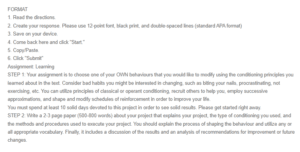Modifying Personal Behavior
Almost everybody has a behaviour they feel is a bad habit and would like to change. In my case, I realized that I do not exercise as much as I should, contributing to my inconsistent body weight. I am keen on living a healthy lifestyle, and even though I religiously stick to my diet, I fail when creating time for physical exercise. Instead, I tend to procrastinate and fail to go for exercises as I should daily. According to Walker (2019), physicians note that individuals should spare 30 minutes daily to exercise, like jogging or skipping a rope. However, I realized that I have developed a tendency to procrastinate and decide that I will exercise the next day, which happens every day until a week or two passes without me engaging in any daily exercises. Therefore, the behaviour to be modified in this case is procrastination. The principles chosen for modification are the principles of operant conditioning.
Methodology
The process of modifying the behaviour took place through the following five steps.
Identifying the Target Behavior
The first step in this process was to isolate and identify the target behaviour. The behaviour to be modified here is procrastinating my decision to create 30 minutes of physical exercise daily. Hence, I isolated procrastination as the target behaviour.
Baseline Recording
The second step was baseline recording. This activity was meant to identify the frequency of the target behaviour and also to identify when the target behaviour occurs. For this process to occur, I kept a journal where I recorded the number of times I procrastinated, creating time for physical exercise. I also recorded the events that motivated me to procrastinate, as supported by Scott et al. (2023). This step was undertaken before I began conditioning.
Reinforcement Schedule
The third step is to set up a reinforcement schedule. I decided to employ a reinforcement schedule given every moment the right behaviour is undertaken. In other words, I rewarded myself whenever I created a day for physical exercise. This reinforcement ensures that the right behaviour is exhibited and the target behaviour is modified.
The Conditioning Process
The fourth step was putting in place the conditioning process. For the reinforcement to be successful and for the conditioning process to be effectively implemented, I decided to bring in one of my best friends to help me implement the conditioning process. As such, any day I failed to create time for physical exercise, my friend would ensure that I had an extra task to undertake as a punishment (Scott et al., 2023). Similarly, my friend also helped reward me when I set aside time for physical exercises.
Approximations
The fifth step was shaping and successive approximations. For this process to succeed, I decided to create time at least thrice or four times a week. Subsequently, I tried to make it five to six times a week, and eventually, I created time every day for physical exercise.
Results and Analysis
For two consecutive weeks, I implemented the conditioning and tried to record the number of times I procrastinated during the intervention. After two weeks, I noticed that I had significantly improved, and my procrastination decreased. The reinforcement approach I employed of a variable-ration schedule worked effectively and helped me have the necessary motivation to schedule my physical exercises every day to get rewards.
Still, based on the events that I recorded, I realized that for the first week after the intervention, I still had a few days when I procrastinated. I noticed that my procrastination was motivated by visits from friends. I realized that I failed to create time for physical exercises when my friend visited me. However, after getting the punishments for failing, I focused more on the rewards, and in the second week, I procrastinated less.
Conclusion
In the end, operant conditioning has worked effectively in helping me modify my targeted behaviour. This project taught me that operant conditioning is powerful in modifying behaviour. Also, from how the project was planned and carried out, I learned that it is important to have persistence and consistency when using conditioning. As such, I plan to continue using the same approach to improve my other weaknesses and change certain behaviours that I feel need modifying.
References
Scott, H. K., Jain, A., & Cogburn, M. (2023). Behavior modification. In StatPearls. StatPearls Publishing.
Walker, S. (2019). Learning theory and behaviour modification. United Kingdom: Taylor & Francis.
ORDER A PLAGIARISM-FREE PAPER HERE
We’ll write everything from scratch
Question

Modifying Personal Behavior
FORMAT
1. Read the directions.
2. Create your response. Please use 12-point font, black print, and double-spaced lines (standard APA format)
3. Save on your device.
4. Come back here and click “Start.”
5. Copy/Paste.
6. Click “Submit”
Assignment: Learning
STEP 1: Your assignment is to choose one of your OWN behaviours that you would like to modify using the conditioning principles you learned about in the text. Consider bad habits you might be interested in changing, such as biting your nails, procrastinating, not exercising, etc. You can utilize principles of classical or operant conditioning, recruit others to help you, employ successive approximations, and shape and modify schedules of reinforcement in order to improve your life.
You must spend at least 10 solid days devoted to this project in order to see solid results. Please get started right away.
STEP 2: Write a 2-3 page paper (500-800 words) about your project that explains your project, the type of conditioning you used, and the methods and procedures used to execute your project. You should explain the process of shaping the behaviour and utilize any or all appropriate vocabulary. Finally, it includes a discussion of the results and an analysis of recommendations for improvement or future changes.


